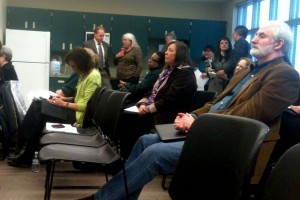The next step in the process to push Portland’s light rail into Vancouver is to secure taxes to fund expenses for operation and maintenance (O&M). Unlike the cost to construct light rail – which is funneled through state and federal taxes – monies for operation and maintenance are derived from taxes at the local level.
To prepare to operate and maintain light rail, C-Tran is considering developing a high capacity transit (HCT) ballot measure that would institute a 0.1% for a larger group or 0.2% sales tax increase for a smaller group.The question of who would be given the opportunity to vote on the HCT ballot measure, and the after effects if the measure ultimately passes, were subjects of heated contention at the March 20 meeting of C-Tran’s Board of Directors.
On the table are two options. The first involves the entire C-Tran district which includes the cities of Vancouver, Battleground, Camas, and Washougal. This option places the lower amount of 0.1% as a sales tax increase on the ballot for a simple up or down vote.
The second option selects a smaller voting group, a sub-district, and doubles the sales tax increase to 0.2%. The sub-district effectively narrows in on those citizens more likely to vote yes on light rail and who supposedly benefit most from the planned high capacity transit, presumably those living in or close to downtown Vancouver. In this case, those in the outlying areas would be spared a potential tax increase, but they would still have access to Vancouver’s light rail system should they choose to use it.
Citizens say, let me vote on light rail
What one side calls sub-districting, however, the other calls gerrymandering and voter disenfranchisement.
Representing those excluded from the proposed sub-district, State Legislator Paul Harris of the 17th District echoed his constituents’ demand to have a voice in the light rail debate. “Just let me vote,” said Rep. Harris, paraphrasing the many emails he has received on the issue. “Don’t cram this down my throat. Just let me vote.”
The majority of citizens and officials attending the meeting expressed similar sentiments. After listening to speaker after speaker cry out “we want to be heard,” newly appointed C-Tran Board Member Connie Jo Freeman, representing Camas and Washougal, reported that her constituents wholeheartedly agree.
Although a few officials in the outlying cities have come out in favor of sub-districting, based on the belief that higher sales tax in Vancouver would cause their constituents to boycott the larger city and shop closer to home, others say this is unrealistic.
“The sad thing about Washougal is we’re so tiny we don’t have a Freddy’s. We don’t have a Costco; we don’t have a mall; we don’t have a Penny’s or Kohl’s,” said Connie Jo Freeman. “We don’t have any of that. In all reality, we have to shop in Vancouver.”
Legal issues mount with tax debate
In light of the fact that residents of the outlying areas of Clark County rely on core merchants to provide some goods and services, the implementation of a C-Tran sub-district begins to reek of taxation without representation. Additional arguments against sub-districting include the possibility of legal complications and the risks inherent in “segregating” C-Tran, i.e., pitting light rail urban users paying a higher sales tax against bus riding suburban area dwellers paying a lower sales tax.
As C-Tran Board Member Steve Stuart contends, “I do believe that we’re an interdependent, interrelated system…that one piece does effect the other…that if you bring light rail in and you’re operating and maintaining it, it will have impact, positive or negative, on our bus system in our outlying communities.”
Also central to the controversy is a public that tends to view the light rail O&M vote as a referendum on the Columbia River Crossing Light Rail Tolling project (CRC). Mayor Tim Leavitt opposes that view and sought to convince the C-Tran Board of his notion that it’s not a vote on whether the public wants light rail or not, it’s a vote on taxes for light rail’s operation and maintenance.
“Some folks are continuing to manipulate this vote as a referendum on the (CRC light rail) project…it is a vote about raising taxes to support operations and maintenance,” said Leavitt.
However, Mayor Leavitt also admitted that, due to state and federal finance stipulations, “without light rail transit, there is not going to be $1.7 to $2 billion of freeway, highway, and interchange improvements on the I-5 corridor.” Although he insists that light rail construction can go forward without seeking tax increases for O&M, no plan has yet been devised to do so.
Regardless of how much impact the high capacity tax initiative would ultimately have on light rail and the CRC in general, residents who oppose the transportation proposals that are currently underway view the vote as a rare opportunity to send a message to the officials that represent them.
In the words of Steve Stuart, “This may be the only way that people will have a chance to have a say on the Columbia River Crossing project. It’s not a referendum. It’s an operation and maintenance bill, but it may be the only chance that people have to have a say on a huge project that has huge impacts on people’s lives and economy.”
Stalemate reeks
The March 20 C-Tran meeting ultimately came to an end without a final vote on the HCT sales tax measure. Perhaps this, more than anything else, demonstrates the contentious and problematic nature of the ongoing debate surrounding Vancouver light rail and the CRC.
Channeling the frustrations of many, concerned citizen Richard Schoen took the Board of Directors to task. “If you guys don’t want to vote, it’s because you are afraid of a vote. And what are you afraid of? Are you afraid that people will tell you you’ve been wrong and spending our money for no good reason all this time? I think that’s what the situation is, and it stinks!”










